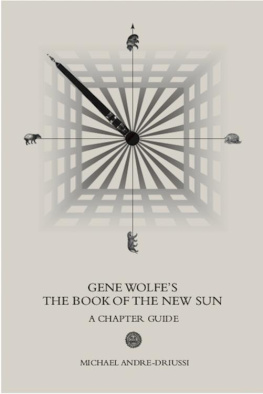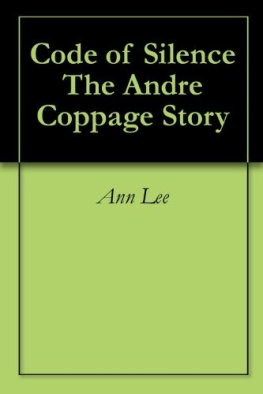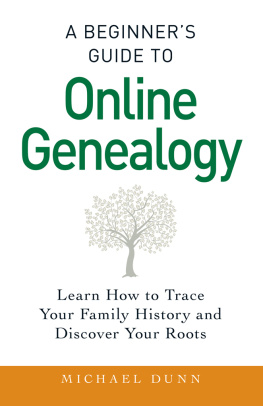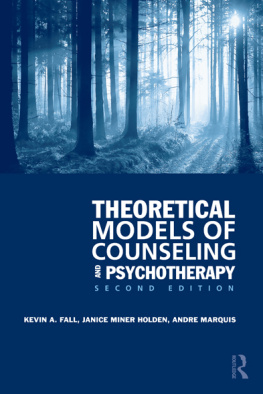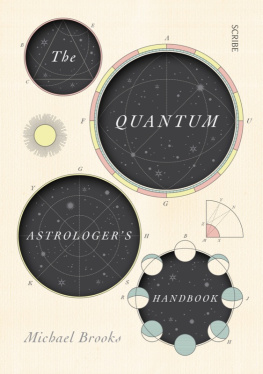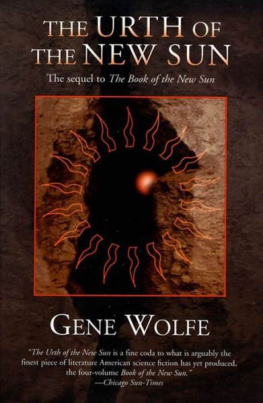Gene Wolfes The Book of the New Sun
A Chapter Guide
Michael Andre-Driussi
Copyright 2019 Michael Andre-Driussi
All rights reserved.
ISBN:978-1-947614-09-3
Cover design The Atrium of Time by Dave Granvold
Contents
DEDICATION
To Gene Wolfe (1931-2019)
I started this project in late 2018 as a long goodbye to Gene Wolfe. His passing away on Palm Sunday of 2019 was very sudden to me, much sooner than I expected.
I learned a great deal from him. Reading The Book of the New Sun led me to read a lot of other books, from Dickens to Proust to the Bible. In many ways Gene Wolfe taught me the way to read.
Gene Wolfe was generous with his time. I corresponded with him by mail for many years. I met him personally seven times. I miss him, but sometimes I have to remind myself he is gone.
Acknowledgments
In my GEnie days (1991-1996?) I discussed the fiction of Gene Wolfe with Greg Feeley, Neil Gaiman, Joe Mayhew, Michael Swanwick, and Jeff Wilson, among others.
I published Lexicon Urthus in 1994. The Lexicon brought me letters from David Langford.
It also brought me friendship with Alice K. Turner (1939-2015), and she talked me into joining the Urth List in 1997. There I met many, but for this application I will limit the roll to Marc Aramini, Robert Borski, Craig Brewer, Bill Carmichael, Roy C. Lackey, Jonathan Laidlow, Dan Parmenter, Nigel Price, Pedro Jorge Romero, and James Wynn.
Introduction
This work is a chapter-by-chapter reading guide to The Book of the New Sun , its sequel The Urth of the New Sun, and four stand-alone Urth stories (The God and His Man, Empires of Foliage and Flower, The Cat, and The Map).
The Guide is a literary supplement for Lexicon Urthus, but it does not replace Lexicon Urthus, nor does it reuse much of the Lexicon.
The Guide is intended to be used by first time readers of The Book of the New Sun as well as those who are reading it again. The idea is that we are reading it together, you and I. There are no spoilers, but things will be noted as they are revealed.
How To Use The Guide
A reader could read a chapter of the source text first, then check in this book for the notes.
Or
A reader could read this book directly.
Pattern Recognition
For this project I follow the lead established by John Clute, Greg Feeley, and Neil Gaiman. Clute, through several Wolfe-related pieces gathered in his collection Strokes (1988), taught me an atomic level of inspection and blazed the trail to the Apollo thread of Severians narrative. Feeley, in a single two-part essay (The Evidence of Things Not Shown: Family Romance in The Book of the New Sun, The New York Review of Science Fiction No. 31 and No. 32, 1991), exposed the literature level of sentence and scene, which might be termed the molecular mode, by citing text traces to such wildly different authors as Shakespeare, James Blish, and Harlan Ellison. Gaiman, through discussion on the GEnie BBS beginning in 1992, shared the excellent strategy of find the author in genial-general and stunning-specific.
These three were in correspondence with each other, sharing notes and ideas, such that at times it becomes difficult to determine the origin point for a particular notion.
Volume I: The Shadow of the Torturer
A thousand ages in thy sight
Are like an evening gone;
Short as the watch that ends the night
Before the rising sun.
Epigraph: From Wolfes article Hands and Feet ( Castle of Days, 228), the epigraph comes from Psalm XC by poet Isaac Watts (1674-1748). This poem, based upon Psalm 90, was collected in The Psalms of David (1719). The relevant verse in the King James Version goes like this: For a thousand years in thy sight are but as yesterday when it is past, and as a watch in the night (Psalm 90:4).
1. Resurrection and Death
Severian, an apprentice torturer, after nearly drowning in the River Gyoll, has difficulty gaining access to the locked graveyard that he and his friends must pass through to return home, until apprentice Drotte plays a psychological trick on the volunteers. Once inside the graveyard, Severian has a chance encounter with the exultant rebel Vodalus and his henchmen robbing a grave. He spontaneously aids the outlaw by killing a volunteer guard. Severian ends the chapter by declaring that his narrative will describe how he backed into the throne.
Chapter Title: The phrase has a reversal, where the wording is usually death and resurrection. Here the resurrection is a bodysnatching (resurrectionist is a euphemistic term for graverobbers in 18th and 19th century British English), and the death is that of two volunteers trying to prevent grave robbing.
Myth: Gyoll (10) in the Norse system is the river of death.
Melville: Relevant to the entry above about an allusion to myth, Ursula K. Le Guin famously called Gene Wolfe our Melville. Presumably she was referring to Herman Melvilles technique of using allusions. The opening of Moby Dick (1851) is the famous line, Call me Ishmael, a Biblical allusion that gives backstory with the swiftness of a lightning strike. Within that same paragraph the narrator mentions the suicide of Cato the Younger, linking to Plutarchs Lives (second century AD). The chapter goes on with bits about the Roman Stoics, Greek myth, Miltons Paradise Lost , and even the philosophical religion of the Pythagoreans. Wolfe uses a similar approach in The Book of the New Sun , as we will see in the course of this Guide.
Mark Twain: Drottes con job with the volunteers is worthy of Tom Sawyer. After Eata darts through the gate, Drotte claims they are herb gatherers, but then when the volunteers are still resistant, he says, If you wont let us gather the herbs, wed better go. I dont think we could ever find that boy in there now (11).
But there is more Twain to this chapter than just that. The novel The Adventures of Tom Sawyer (1876) has a pivotal scene in a graveyard. It is in chapter 9, when Tom and Huck go out to the cemetery at night to perform experiments with a dead cat. There they chance upon a trio who have just robbed a grave of its corpse. An argument among the thieves, which leads to murder, is witnessed in secret by the boys. This incident propels the rest of the novel.
Dickens: Severian meeting Vodalus in the necropolis (13) echoes the first chapter of Charles Dickenss Great Expectations (1861) where young Pip encounters the convict Magwitch in a graveyard. In his 1991 essay, Greg Feeley denotes this Dickensian allusion oft-remarked ( New York Review of Science Fiction No. 32, p. 13).
Paradoxes to Perfect Memory: Roche or Drotte? In the first pages, when the apprentices are outside the necropolis, Severian writes: Roche held me, saying, Wait, I see pikes (10). A few paragraphs later, Severian makes his first allusion to his unusual memory: (which in the final accounting loses nothing), yet in the next paragraph Severian writes, but they had pikes, as Drotte had said.
So which is it: Roche, or Drotte?
This curious situation was first noted on the Urth List by Bill Carmichael (18 OCT 1999). It spurred Roy C. Lackey into tracking, and he came up with a theory: Whenever in the text Severian starts vaunting his perfect memory, not always, but often enough, that the particular memory then recounted, or another close by in the text, will be flawed (9 JUL 2003).
In this manner, the perfect memory of Severian is paradoxed.
Animal Form: Theas voice is likened to a doves call (13); Thea herself is described as a dove, while the heavy man is announced an arctother, a cave bear.
Commentary: The three volunteers facing Vodalus are the leader, armed with a long knife (10), to whom Drotte had spoken (10-11; 15); the pikeman (15) who runs away (16); and the man with the ax, whom Severian kills. The axman might be the one who had said Im going to watch over my mother (12), and thus he was probably the son of the dead woman whose body was taken away.

